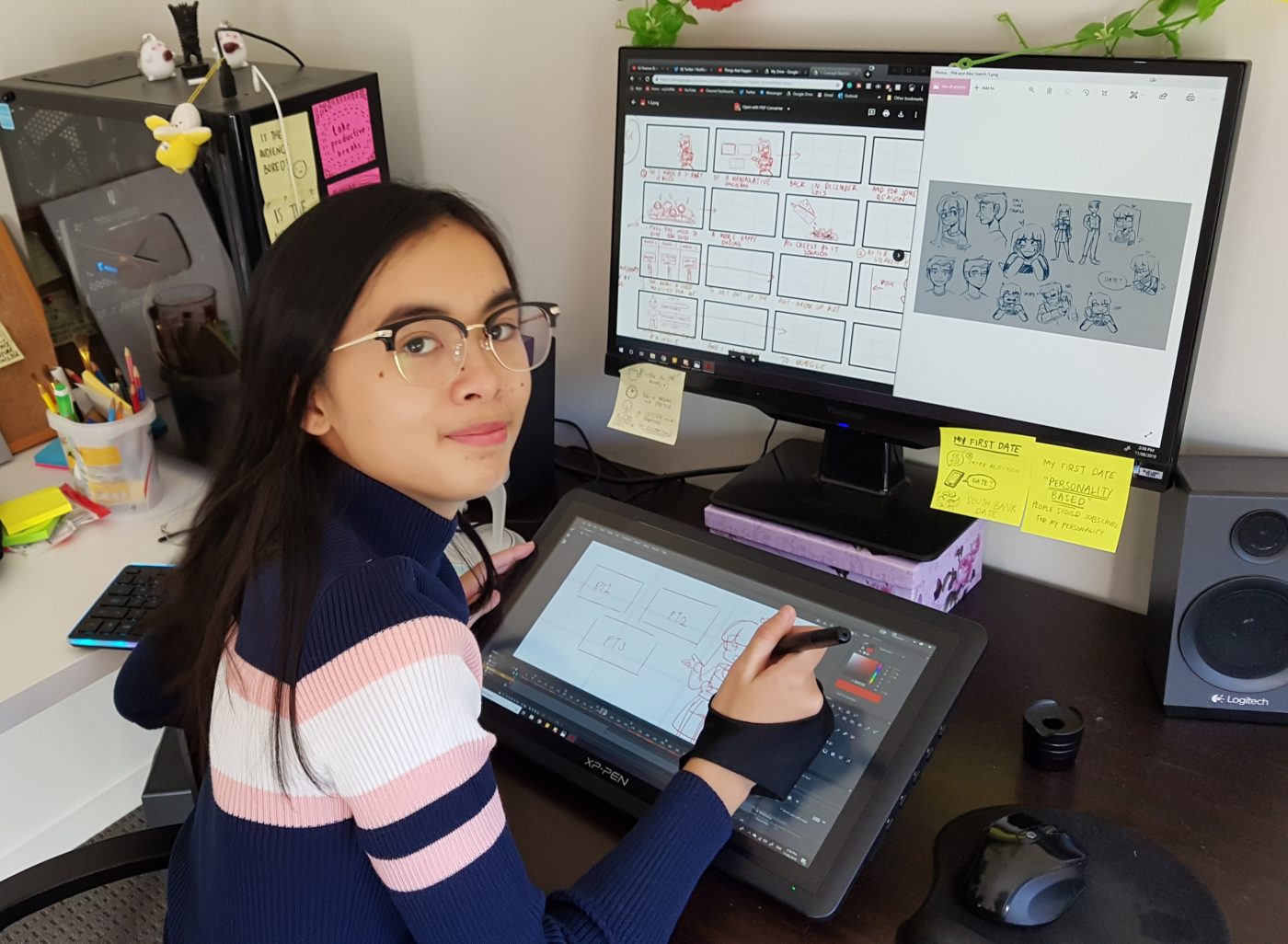Griffith Film School students and alumni are plunging into the brave new world of online content and connecting with millions of viewers across the globe.
The web is now the number one platform for young filmmakers, who are attracting large audiences on YouTube with everything from drama series to comedy shorts and animation.
Hard work pays off
 Griffith Film School Bachelor of Animation student Alex Ang is just 20 years old, but she is reaping the rewards of her massive following on YouTube.
Griffith Film School Bachelor of Animation student Alex Ang is just 20 years old, but she is reaping the rewards of her massive following on YouTube.
Her YouTube channel, Alex’s Corner, has more than 340,000 subscribers, and her anime-inspired clips on relationship dramas and social etiquette regularly attract more than 3 million views.
“It feels very rewarding, and it’s great to know my work is being enjoyed by so many people,” she said.
“I was always that artistic kid – I loved anime and Disney, and I have a passion for storytelling.
“I just try and share things that I’ve experienced – friendship dramas, relationships – ordinary stories that people can relate to.”
The channel started off as a side project to showcase her animation skills, and has become a thriving business – albeit one that she juggles with her studies.
“I wanted to get a part-time summer job, and didn’t get any interviews, so I decided to see how far I could go sharing my animation work,” she said.
“I consider my YouTube channel my portfolio – it’s a great way to showcase everything I’ve learned at uni.
“I’ve made more than 100 videos that are all self-funded, all directed and scripted by me – it’s liberating being your own boss.
“But it took a year before I earned any money from my channel – and I got lucky that the YouTube algorithm fished out one of my videos and recommended it to virtually everyone on the platform, so I had a massive spike in subscribers.
“Each video can take months to create, so I’ve put in a lot of hard work, and it’s starting to pay off.”
Fresh, funny and irreverent
 Griffith Film School graduate Connor McDuff is the creator and star of the Cracker Milk YouTube channel, which has more than 50,000 subscribers from around the world.
Griffith Film School graduate Connor McDuff is the creator and star of the Cracker Milk YouTube channel, which has more than 50,000 subscribers from around the world.
“Our niche is comedy, and we have a strong following in the US,” he said.
“We’re currently in talks to create content for CollegeHumor, an American comedy channel that has a huge reach – they have more than 13 million subscribers and 6 billion views.”
In 2016, Connor produced the first web series on the Griffith Film School graduate slate. The resulting three-part comedy series, F****ed Fairytales, was nominated for an Australian Online Video Award.
“Most people do a short film for their graduate project, but I’ve loved online for years, and I thought I may as well make something I’m passionate about,” he says.
“I think you can create stuff for online that is irreverent, individual and unique.”
The young filmmaker has been posting clips on YouTube since he was in high school, and has found that audiences of all ages are flocking online in search of fresh, funny content.
“I started when I was 14 with an old VHS camera and a tripod,” he says.
“People see a video go viral and put it down to dumb luck — but you have to work so long and hard before you get to that level.
“Some of my clips have had almost a million hits, which is insane.
“People are taking it seriously — and with platforms like ABC iView and SBS On Demand, a lot of online series are funded and have great production values.”
Opening the door for diverse voices
Griffith Film School Masters of Screen Production alumni recently produced an acclaimed 9-part web series, Two Weeks.
Set in Brisbane, it follows a group of 20-something LGBT friends as they tackle big decisions about relationships, friendship, sexuality, careers.
 Griffith Film School alumnus Rhiannon Steffensen produced the series, which has now had more than a million views on YouTube since it launched six months ago.
Griffith Film School alumnus Rhiannon Steffensen produced the series, which has now had more than a million views on YouTube since it launched six months ago.
“We are lucky that we decided to do a web series just as the format was taking off,” she said.
“Now it’s the main way that people consume media – to have tapped into that is really exciting.
“A million views is a real milestone, and the majority of our audience is actually overseas.
“Knowing that our work is being watched all over the world is amazing.”
Ms Steffensen said the creative team had been able to use the first series to gain a foothold in the film industry, with approaches from Screen Queensland and a host of independent producers.
“We made 90 minutes of drama, which is equal to a feature film,” she said.
“We’ve now got a really solid proof of concept, and the response from the local industry has been immense.”
The series was produced with the assistance of GFS production arm, LiveLab, and Griffith Film School students and alumni formed the creative team and crew.
“We used every alumni we could think of on the crew, and it was really a big Griffith family,”she said.
“It shows people that students can tackle these bigger projects and really rise to the challenge.
“We’re so proud to be a part of the Griffith filmmaking community – it pushes you further and makes you passionate when you’re supported to create work on this scale.”
An industry on the move
Griffith Film School alumnus Martin Ingle has developed several web series – a major online documentary project Into the Middle of Things and a new satirical web series, F Off We’re Full.
The comedy series follows a group of fictional white nationalists who face in-fighting after they’re confined to house arrest, and features several high profile media identities, including ABC / SBS satirist Mark Humphries.
 Martin, who was selected to join the popular ABC series The Chaser in the US in the lead-up to the last presidential election, said that new online platforms had made it easier for emerging filmmakers to showcase their work.
Martin, who was selected to join the popular ABC series The Chaser in the US in the lead-up to the last presidential election, said that new online platforms had made it easier for emerging filmmakers to showcase their work.
“I graduated university ten years ago, and there has been a huge change in the industry,” he said.
“Since then, the barriers to entry have been lowered so much – the platforms and equipment allow so many more people to create content.
“The short film used to be the path for emerging filmmakers, you would submit it to festivals internationally, and at best 100 people in a cinema across the world would see it.
“Now you can make something, put it online and the potential audience is millions of people around the world.”
